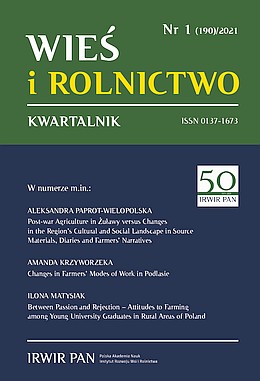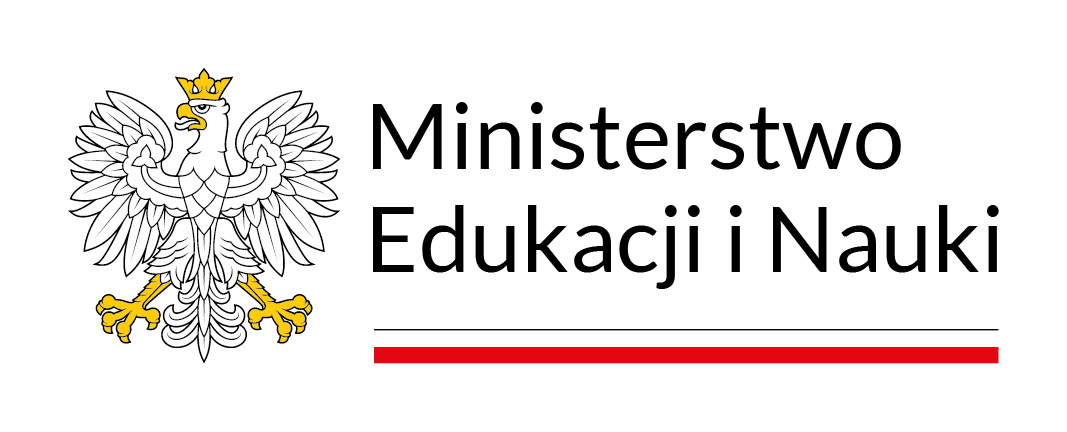Czy kryzys demograficzny zagraża europejskiemu i polskiemu rolnictwu?
DOI:
https://doi.org/10.53098/wir012021/05Słowa kluczowe:
wiek, kryzys demograficzny w rolnictwie, rodzinne gospodarstwa rolne, młodzi rolnicy, WPRAbstrakt
W ostatnich dekadach problemy rolnictwa rodzinnego sprzęgają się z kryzysem demograficznym. Na tle niekorzystnych prognoz i procesów ludnościowych polityka rolna UE niezmiennie akcentuje strategiczne znaczenie rolnictwa rodzinnego i potrzebę jego rozwoju jako żywotnego segmentu gospodarki oraz rdzenia społeczności wiejskich. Celem artykułu jest ocena uzasadnień polityki ukierunkowanej na zahamowanie kryzysu demograficznego w rolnictwie UE, jak również wstępne przedstawienie efektów realizacji instrumentu dotacji dla gospodarstw prowadzonych przez młodych rolników na przykładzie Polski. Z przeprowadzonych analiz wynika, że mechanizmy przyspieszenia zmian generacyjnych w rolnictwie w UE miały dyskusyjne przesłanki i nie były dostosowane do potrzeb zaznaczających się na poziomie krajowym i regionalnym. W unijnych dokumentach strategicznych i debacie publicznej wsparcie dla wymiany pokoleniowej w rolnictwie opiera się na argumentach diagnozujących szczególnie niekorzystną sytuację demograficzną tego sektora. Artykuł pokazuje, że stanowisko to jest zbyt ogólne i uproszczone, ponieważ nie uwzględnia długookresowych zmian populacyjnych, sytuacji w innych branżach gospodarki oraz różnych kontekstów społeczno-ekonomicznych i instytucjonalnych w państwach członkowskich, a także ogranicza się do wąskiego zakresu, często nieporównywalnych danych. Obecnie trudno znaleźć podstawy do twierdzeń, iż dotacje dla młodych rolników rozwiązały problemy gospodarstw bez następców i przyczyniały się do odmłodzenia populacji rolników. Na potrzeby artykułu wykorzystano różne źródła danych i informacji, w tym: akty prawa UE i prawa krajowego, opracowania tematyczne i eksperckie dotyczące problematyki demograficznej w rolnictwie oraz materiał empiryczny zgromadzony przez instytucje publiczne.
Bibliografia
Adamowicz M. (2015). Wspólna Polityka Rolna wobec rodzinnych gospodarstw rolnych stanowiących podstawę europejskiego modelu rolnictwa. In: A. Chlebicka (ed.), Ekonomiczne mechanizmy wspierania i ochrony rolnictwa rodzinnego w Polsce i innych państwach Unii Europejskiej (pp. 45–46). Warszawa: Fundacja Programów Pomocy dla Rolnictwa FAPA.
Adamowicz M., Szepeluk A. (2016). Wsparcie młodych rolników jako element polityki rolnej Unii Europejskiej. Zagadnienia Ekonomiki Rolnej, 3 (348), 106–128. DOI: https://doi.org/10.5604/00441600.1218186
Bernstein H., Friedmann H., Ploeg J.D. van der, Shanin T., White B. (2018). Forum: Fifty years of debate on peasantries, 1966–2016. The Journal of Peasant Studies, 45 (4), 689–714. DOI: https://doi.org/10.1080/03066150.2018.1439932
Bretoni D., Cavicchioli D., Latruffe L. (2016). Impact of succession on performance: the case of the Italian family farms. Paper prepared for the presentation at the 149th EAAE Seminar Structural change in agri-food chains: new relations between farm sector, food industry and retail sector, October 27–28, Rennes, France.
Burton R.J.F., Fischer H. (2015). The succession crisis in European agriculture. Sociologia Ruralis, 55 (2), 155–166. DOI: https://doi.org/10.1111/soru.12080
Chiswell H.M., Lobley M. (2015). A recruitment crisis in agriculture? A reply to Heike Fischer and Rob J.F. Burton’s Understanding farm succession as socially constructed endogenous cycles. Sociologia Ruralis, 55 (2), 150–154. DOI: https://doi.org/10.1111/soru.12071
Chiswell H.M., Lobley M. (2018). “It’s definitely a good time to be a farmer”: Understanding the changing dynamics of successor creation in late modern society. Rural Sociology, 83 (3), 630–653. DOI: https://doi.org/10.1111/ruso.12205
Davies J., Caskie P., Wallace M. (2013). How effective are new entrant schemes for farmers?. EuroChoices, 12 (3), 32–36. DOI: https://doi.org/10.1111/1746-692X.12038
Dudek M. (2015). Miejsce polskiego rolnictwa w strukturach rolnictwa europejskiego. In: A. Sikorska (ed.), Kierunki przeobrażeń strukturalnych oraz uwarunkowania rozwoju rolnictwa i obszarów wiejskich (pp. 61–79). Monographs of Multi-Annual Programme. Warszawa: IAFE-NRI.
Dudek M., Pawłowska A. (2020). Czy sukcesja może poprawić sytuację ekonomiczną rodzinnych gospodarstw rolnych w krótkim okresie? Wyniki badań panelowych na przykładzie Polski, typescript.
European Commission (1996). Young farmers and the problem of succession. Report from the Commission, COM(96) 398 final, Brussels.
European Commission (2010). The CAP towards 2020: Meeting the food, natural resources and territorial challenges of the future. Communication from the Commission to the European Parliament, the Council, the European Economic and Social Committee and the Committee of the Regions, Brussels.
European Commission (2012). Generational renewal in EU agriculture: Statistical background. EU Agricultural Economic Brief No 6, European Commission. Available: https://ec.europa.eu/info/sites/info/files/food-farming-fisheries/farming/documents/agri-economics-brief-06_en.pdf [access: 3rd September 2020].
European Commission (2015). Young farmers and the CAP. Publications Office of the Luxembourg: European Union.
European Commission (2017). Commissioner Hogan highlights importance of European young farmers. Available: https://ec.europa.eu/info/news/commissioner-hogan-highlights-importance-european-young-farmers_pl [access: 3rd September 2020].
European Commission (2019). Evaluation of the impact of the CAP on generational renewal, local development and jobs in rural areas. Final Report. (2019). CCRI, OIR, ADE.
European Council of Young Farmers (CEJA) (2017). Young farmers are key in the future CAP. Available: https://wordpress.ceja.eu/wp-content/uploads/2019/09/Final-Young-Farmers-are-Key-in-the-Future-CAP-BW-1.pdf [access: 27 July 2020].
European Court of Auditors (2017). EU support to young farmers should be better targeted to foster effective generational renewal. Special report no 10.
European Parliament (2018). Report on the implementation of CAP young farmers’ tools in the EU after the 2013 reform. Available: https://www.europarl.europa.eu/doceo/document/A-8-2018-0157_EN.html [access: 2nd December 2020].
Eurostat (2020a). Employees by sex, age and occupation (1000). Available: https://ec.europa.eu/eurostat/web/products-datasets/product?code=LFSQ_EEGAIS [access: 2nd December 2020].
Eurostat (2020b). Farm structure survey – survey coverage, Statistics Explained. Available: https://ec.europa.eu/eurostat/statistics-explained/index.php?title=Farm_structure_survey_%E2%80%93_survey_coverage [access: 2nd December 2020].
Fargues P., McCormick A. (2013). Ageing of skills and complementary immigration in the EU, 2010–2025. EUI Working Papers, RSCAS 2013/81, Migration Policy Centre, 1–13. DOI: https://doi.org/10.2139/ssrn.2378816
Figiel S. (2019). Józef Stanisław Zegar: Perspektywy gospodarstw rodzinnych w Polsce (The perspectives of family farms in Poland) (polemika). Zagadnienia Ekonomiki Rolnej, 4 (361), 169–172.
Fisher H., Burton R.J.F. (2014). Understanding farm succession as socially constructed endogenous cycles. Sociologia Ruralis, 54 (4), 417–438. DOI: https://doi.org/10.1111/soru.12055
Goraj L., Olewnik E. (2014). FADN i Polski FADN (Sieć danych rachunkowych gospodarstw rolnych i system zbierania i wykorzystywania danych rachunkowych z gospodarstw rolnych). Warszawa: Polski FADN, Instytut Ekonomiki Rolnictwa i Gospodarki Żywnościowej – Państwowy Instytut Badawczy.
Gorlach K., Starosta P. (2018). Rodzinne gospodarstwa rolne w społecznościach wiejskich: zmiany organizacji życia społecznego wsi w świecie nowoczesnym i ponowoczesnym. Roczniki Nauk Społecznych, 10 (46), 17–42. DOI: https://doi.org/10.18290/rns.2018.46.4-2
Jarosz L. (2008). The city in the country: Growing alternative food networks in Metropolitan areas. Journal of Rural Studies, 24 (3), 231–244. DOI: https://doi.org/10.1016/j.jrurstud.2007.10.002
Joosse S., Grubbstrom A. (2017). Continuity in farming – Not just family business. Journal of Rural Studies, 50, 198–206. DOI: https://doi.org/10.1016/j.jrurstud.2016.11.018
Lobley M. (2010). Succession in family farm business. Journal of Farm Managing, 13 (12), 839–851.
Lobley M., Butler A., Reed M. (2009). The contribution of organic farming to rural development: An exploration of the socio-economic linkages of organic and non-organic farms in England. Land Use Policy, 26, 723–735. DOI: https://doi.org/10.1016/j.landusepol.2008.09.007
Matthews A. (2018). Is there a particular generational renewal problem in EU agriculture? Available: http://capreform.eu/is-there-a-particular-generational-renewal-problem-in-eu-agriculture [access: 16th February 2020].
Michalska S. (2015). Rolnictwo rodzinne a świat w przyszłości. Wieś i Rolnictwo, 1 (166), 187–195.
Milne C., Butler A. (2014). Young entrants to farming: explaining the issues. SRUC RPC PB 2014/02, Rural Policy Centre, Policy Briefing. Available: https://www.sruc.ac.uk/downloads/file/1880/2014_young_entrants_to_farming_explaining_the_issues [access: 16th February 2020].
Moehler R. (2008). The internal and external forces driving CAP reforms. In: J.F.M. Swinnen (ed.), The Perfect Storm: The Political Economy of the Fischler Reforms of the Common Agricultural Policy (pp. 76–83). Brussels: Centre for European Policy Studies.
Rachel B., Grundy E., Robine J.-M., Cylus J., Mackenbach J.P., Knai C., McKee M. (2013). Ageing in the European Union. Lancet, 381, 1312–1322. DOI: https://doi.org/10.1016/S0140-6736(12)62087-X
Regulation (EU) no 1305/2013 of the European Parliament and of the Council of 17 December 2013 on support for rural development by the European Agricultural Fund for Rural Development (EAFRD) and repealing Council Regulation (EC) No 1698/2005.
Regulation (EU) no 1307/2013 of the European Parliament and of the Council of 17 December 2013 establishing rules for direct payments to farmers under support schemes within the framework of the common agricultural policy and repealing Council Regulation (EC) No 637/2008 and Council Regulation (EC) No 73/2009.
Ross Gordon Consultants SPRL (2000). The future of young farmers in the European Union. Working paper. Luxembourg: European Parliament.
Rural Development Programme for 2007–2013 (2007). Warsaw: MARD.
Rural Development Programme for 2014–2020 (2013). Warsaw: MARD.
Sectoral Operational Programme Restructuring and modernisation of the food sector and rural development 2004–2006 (2004). Warsaw: MARD.
Sroka W., Dudek M., Wojewodzic T., Król K. (2019). Generational changes in agriculture: The influence of farm characteristics and socio-economic factors. Agriculture (Switzerland), 9 (12), 1–27. DOI: https://doi.org/10.3390/agriculture9120264
Stępień S., Czyżewski A. (2016). Economic aspects of the implementation of the Rural Development Programme 2014–2020. Reminiscences and projection. Journal of Agribusiness and Rural Development, 4 (42), 651–658. DOI: https://doi.org/10.17306/JARD.2016.91
The World Bank (2017). Thinking CAP. Supporting agricultural jobs and income in the EU. Washington DC: The World Bank.
Tomczak F. (2005). Gospodarka rodzinna w rolnictwie. Uwarunkowania i mechanizmy rozwoju. Warszawa: Instytut Rozwoju Wsi i Rolnictwa Polskiej Akademii Nauk.
Tomczak F. (2009). Ewolucja wspólnej polityki rolnej UE i strategia rozwoju rolnictwa polskiego. Monographs of Multi-Annual Programme 125. Warszawa: IAFE-NRI.
Wieliczko B., Kurdyś-Kujawińska A., Herda-Kopańska J. (2017). Mechanisms and impulses influencing development of agriculture and rural areas (3). Monographs of Multi-Annual Programme 58.1. Warsaw: IAFE-NRI.
Wigier M. (2019). Alokacyjne i dystrybucyjne dylematy polityki rolnej na przykładzie polskiego sektora rolno-spożywczego w okresie 1989–2018. Warszawa: IAFE-NRI.
Wojewodzic T. (2013). Pozorna sukcesja – zaburzenie cyklu życia gospodarstw rolniczych. Zeszyty Naukowe Szkoły Głównej Gospodarstwa Wiejskiego w Warszawie. Ekonomika i Organizacja Gospodarki Żywnościowej, 103, 141–152. DOI: https://doi.org/10.22630/EIOGZ.2013.103.35
Viira A.-H., Poder A., Varnik R. (2014). Discrepancies between the intentions and behaviour of farm operators in the context of farm growth, decline, continuation and exit – Evidence from Estonia. German Journal of Agricultural Economics, 63, 46–62.
Zagata L., Hrabák J., Lošťák M., Bavorová M., Ratinger T., Sutherland L.-A., McKee A. (2017). Research for AGRI Committee – Young farmers – policy implementation after the 2013 CAP reform. Brussels: European Parliament, Policy Department for Structural and Cohesion Policies.
Zagata L., Sutherland L.-A. (2015). Deconstructing the “young farmer problem in Europe”: Towards a research agenda. Journal of Rural Studies, 38, 39–51. DOI: https://doi.org/10.1016/j.jrurstud.2015.01.003
Zegar J.S. (2018). Kwestia agrarna w Polsce. Warszawa: IAFE-NRI. DOI: https://doi.org/10.30858/mon/9788376587424
Zhengfei A., Lansink O.A. (2006). The source of productivity growth in Dutch agriculture: A perspective from finance. American Journal of Agricultural Economics, 88 (3), 644–656. DOI: https://doi.org/10.1111/j.1467-8276.2006.00885.x
Ziętara W. (2018). Family farms in Poland: present condition and development directions. Problems of Small Agricultural Holdings, 4, 89–103. DOI: https://doi.org/10.15576/PDGR/2018.4.89
Zondag M.-J., Lauwere C. de, Sloot P., Pauer A. (2015a). Executive summary. Pilot project: Exchange programmes for young farmers. Brussels: European Commission, Directorate-General for Agriculture and Rural Development.
Zondag M.-J., Lauwere C. de, Sloot P., Pauer A. (2015b). Needs of young farmers. Report 1 of the pilot project: Exchange programmes for young farmers. Brussels: European Commission, Directorate-General for Agriculture and Rural Development.











